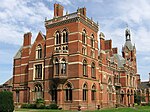Church of St Michael and All Angels, Averham
Church of England church buildings in NottinghamshireGrade I listed churches in NottinghamshireUnited Kingdom Anglican church building stubsUse British English from March 2021

The Church of St. Michael and All Angels, Averham is a parish church in the Church of England in Averham, Nottinghamshire. The church is Grade I listed by the Department for Digital, Culture, Media and Sport as a building of outstanding architectural or historic interest.
Excerpt from the Wikipedia article Church of St Michael and All Angels, Averham (License: CC BY-SA 3.0, Authors, Images).Church of St Michael and All Angels, Averham
Newark and Sherwood
Geographical coordinates (GPS) Address Nearby Places Show on map
Geographical coordinates (GPS)
| Latitude | Longitude |
|---|---|
| N 53.081111111111 ° | E -0.86222222222222 ° |
Address
NG23 5RA Newark and Sherwood
England, United Kingdom
Open on Google Maps








